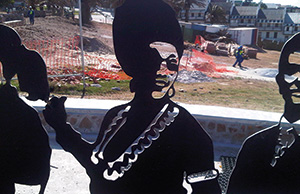Mark Robinson examines the differences between the arm’s length principle in political South Africa and England – and looks at what needs to change

When I first visited South Africa in 2006, as part of the Swallows Partnership between the Eastern Cape and North East England (AP218), I realised something was very different to England. It was exciting to be in a place that still felt political, rather than the post-political place England seemed to have become. This post-political feeling was not, for me, that ‘all politicians are the same’ feeling – rather it seems there was no alternative to an all-pervasive, history- and class-blind, essentially retail-based version of the relationship between individuals, and between the state and the individual.
I visited South Africa again recently, as Chair of the Swallows Foundation UK, which is working with partner organisation Isiseko Senkonjane to create cultural exchange and build capacity in both regions, and as a writer. This involved meeting many writers, editors and teachers in Grahamstown, under the careful chaperonage of poet Sonwabo Meyi. I was struck again by some comparisons that could be drawn; now our own situation in the UK suddenly feels very political and ideological indeed. Amongst many things I could discuss, from the differences in poetic styles to how to stretch money and support further, I want to focus on one.
VIEW FROM ABROAD
The funding system and situation in South Africa is, on the surface, quite similar to the current UK model. An arm’s length body (National Arts Council of South Africa) gives grants to major organisations, of up to 3 years duration. There is a separate body distributing Lottery funds to community causes, including the arts, which looks after much project funding. Provincial and local government support some arts organisations. There is an interest in creative industries development and cultural tourism. There is an Arts & Business organisation cultivating sponsorship and philanthropy. There is a big concentration of funds on major, national institutions in Johannesburg, Cape Town and Durban, just as England has in London.
Talk to artists, writers and people who run arts organisations, and the conversation is also very similar to one you might have in England. Frustration with the money available, with the conditions artists work in and with the slow machinery of bureaucracy, cohabit with passion, creativity, some courageous backing and investment, and a determination to make work happen, whatever it takes. This is especially invigorating in the South African context, which is still one of building a new democratic nation, with all the challenges and awkwardnesses that brings. (Many of the younger people I met were especially frustrated at the pace and spread of change, something we are likely to see in the UK, I suspect. It’s not a healthy development to cut education and career opportunities simultaneously.)
SHRINKING THE DISTANCE?
But if there is an arm’s length principle in South Africa, I was told it has, at times, short arms. This is arguably understandable given the imperatives the country faced in dismantling apartheid. Change is always political. Governments, at national, provincial and local levels, see the arts as part of that and are active in shaping strategy. What arts institutions do and represent is debated in a way we have largely dispensed with in the UK, subsuming critique with what you might call the narratives of participation or economic return. Preserving mass participation via free entry often seems the dominant argument in UK museums, for instance, rather than what they are representing, how and to whom.
The UK ‘arm’s length principle’ has been too often referred to and too little examined. One of the most significant aspects of the recent Comprehensive Spending Review (CSR) was the ‘allocation’ letter to ACE. This represents a significant redefinition of the arm’s length principle. Individual funding decisions are, admittedly, left to ACE. (Though I wonder what conversations would take place if one of the ‘big beasts’ were to not make it into the National Portfolio in March?) Beyond that though, the letter basically instructs ACE on budget issues to an unprecedented level, including timetable, staffing and some strategic priorities. It’s basically a set of IKEA, sorry DCMS, instructions for the next business plan. The areas for international focus, for instance, are explicit governmental priorities, not ones chosen for artistic or cultural reasons.
ELECTED REPRESENTATIVES
Now, Jeremy Hunt is an elected politician, and there is an argument that elected members at local and national level should actively shape strategy and activity. My point is not to debate that here. The CSR letter, let alone the previous decade’s experience of New Labour, suggests that the arm’s length principle was a myth for a country that thought it had gone beyond politics. A response requires, however, that artists and organisations – including arts councils – need to understand this is a political environment, and act accordingly. This means organising, lobbying and arguing in an explicitly political fashion, rather than brushing over that or suggesting culture is not in some sense political. The arm’s length bodies need to stretch their arms out also, and become more explicit (and visible) in their opposition to what they feel is just wrong about direction, building on their opposition to cuts, but making it clear the real choices are about more than just size of budget.
Mark Robinson runs arts consultancy Thinking Practice.
w http://www.thinkingpractice.co.uk



